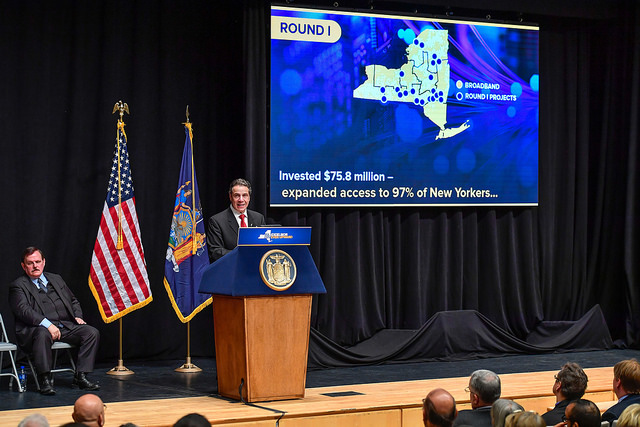
Gov. Cuomo (photo: The Governor's Office)
New research released last month by JobsFirstNYC and the Community Service Society found that more than 136,000 young adults 18-24 years old in New York City are not working and not enrolled in school. And despite increased enrollment, equity gaps in college completion have widened in New York City. Meanwhile, all of the employment gains for members of this age group over the last five years has been in low-wage, part-time work. But New York City’s young adults are not the only group facing barriers to enter and succeed in an increasingly more skilled labor market, as more than 40 percent of residents across the state only have a high school diploma or less in a time when employers are crying out for more trained workers.
Recognizing the urgent need to invest in human capital, Governor Cuomo put forward a promising vision that will put the state on a path to realizing the full potential of all New Yorkers and the Legislature worked with him to include it in a final budget deal (read Governor Cuomo’s Workforce Investment Plan is a Promising Start for overview of the governor’s original proposal). This is a victory for New Yorkers. The governor and the state Legislature should be applauded.
Included in the final New York State budget for the fiscal year that began April 1 is an unprecedented $175 million for workforce development, which will flow through a Consolidated Funding Application (CFA) process likely to begin as early as this spring. The final deal is not all that different from what Governor Cuomo proposed back in January and gives a great deal of autonomy to him to design and manage the CFA process and decide how best to allocate resources regionally. Because of the flexibility the executive chamber has, it’s safe to assume that the resources will be connected in some way to (and potentially managed out of) Empire State Development and the Regional Economic Development Councils, as was outlined in the governor’s original proposal. Wherever the CFA process ends up, the $175 million must be regionally-targeted, support multi-year strategies, and be available on a rolling basis.
The only real mandate by the Legislature included in the final budget deal is to work with the State Workforce Investment Board and the agencies that currently administer workforce development programs (New York Department of Labor, SUNY, CUNY, etc.). The legislation states: “Services and expenses for workforce development shall be administered in consultation with the state workforce investment board and state agencies responsible for administration of workforce development programs.”
In addition to establishing a CFA process to allocate the $175 million across the state, the governor also put forward three other workforce development proposals that were not part of adopted budget legislation. This includes establishing a New York State Office of Workforce Development, building a state-of-the-art data analytics infrastructure modeled after Monroe Community College’s, and creating a one-stop-shop online platform for job-seekers and employers. The good news for these initiatives is that the governor has the administrative authority to do them without the need to pass legislation.
The Legislature’s mandate to work with all the agencies that currently provide workforce development and training programs as well as to work in consultation with the state’s Workforce Investment Board to coordinate the CFA process should be treated as the first task of the soon-to-be-created New York State Office of Workforce Development. With $175 million of workforce development resources secured, this new office has a unique opportunity to create a responsive, 21st century workforce unleashing the full economic power of the state.
To realize this vision, Governor Cuomo must also charge the Office of Workforce Development to create a more integrated workforce development system that ensures there is dedicated state-funded revenue stream year-to-year and braids together existing funding streams for programs (TANF, SNAP E&T, WIOA, etc.) with similar goals, as well as establishes a shared framework for measuring outcomes. Additionally, this office must work across government to align the education, human services, economic, and workforce development systems. In doing so, the state will need to invest in demand-driven innovative ideas and partnerships to create a structurally adaptable and responsive workforce development system. Finally, this newly created office must make shared outcomes, accountability, and transparency the ‘new normal.’
Fortunately, Governor Cuomo and the soon-to-be named Director of the Office of Workforce Development does not need to do this alone. The Invest In Skills NY initiative—a diverse statewide coalition of employers, training providers, intermediaries, higher education institutions, professional and trade associations, young adult groups, and many others who make-up the workforce development system are ready to work to bring New York State’s labor force into the 21st century.
***
Kevin Stump is vice president of Policy, Communications, and In-School Practice at JobsFirstNYC and co-chair of the Invest In Skills NY Campaign. On Twitter @KevinStump and @JobsFirstNYC; #InvestInSkillsNY.




